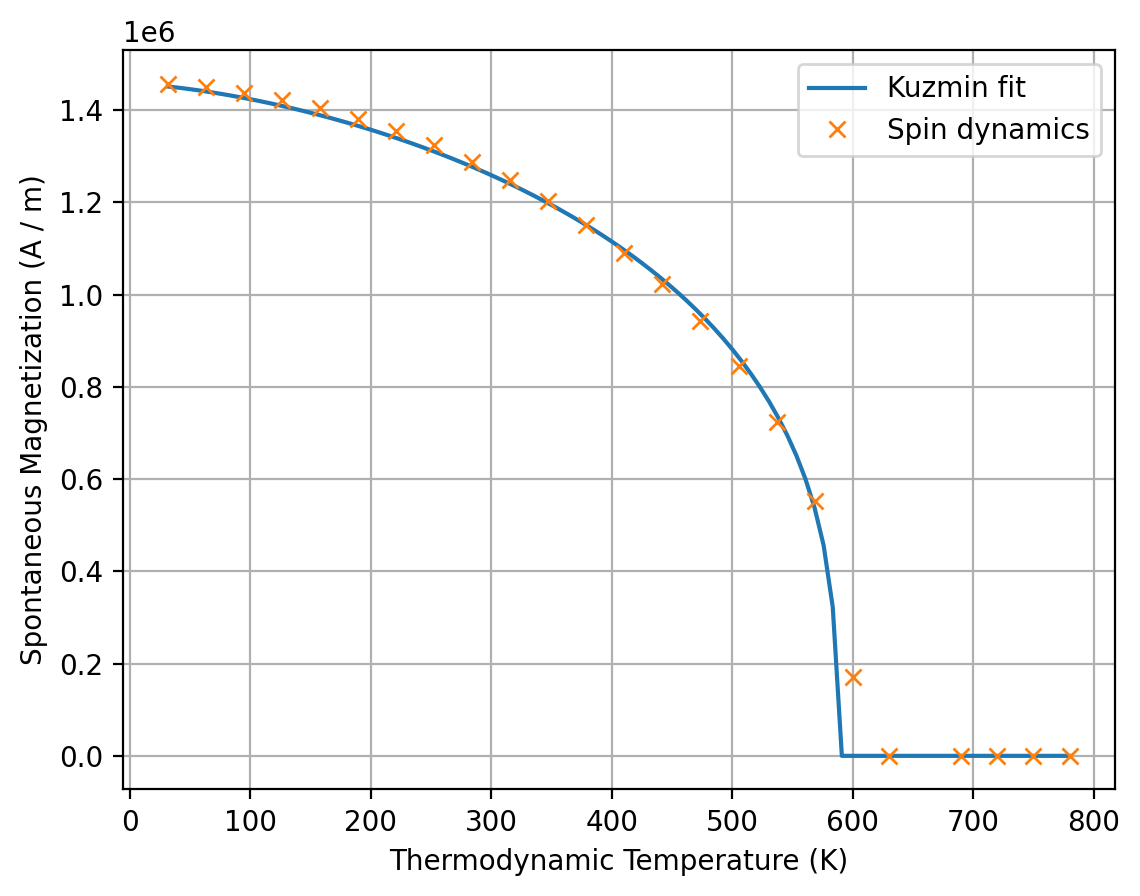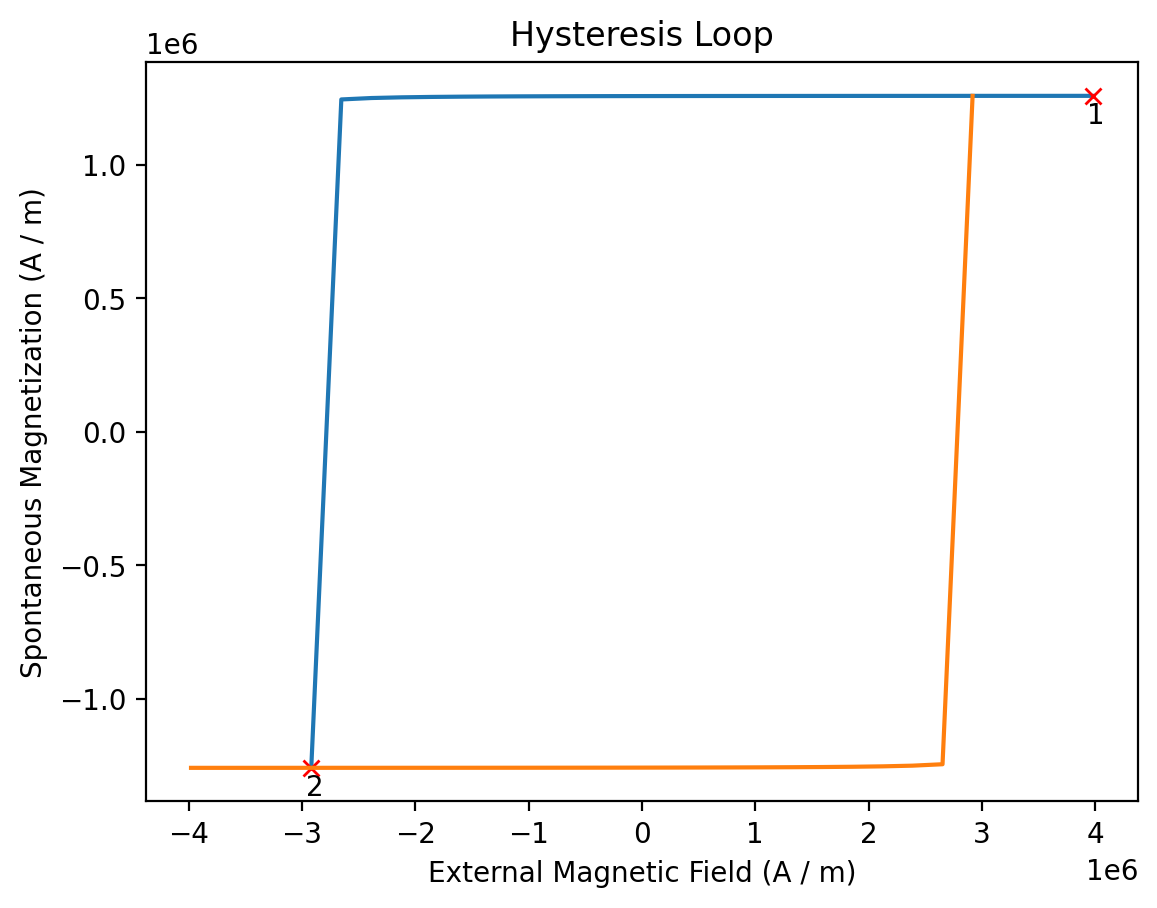Hard magnet tutorial#
Introduction#
In this notebook we explore hard magnet properties such as Hc as function of temperature for Fe16N2.
We query databases to get temperature-dependent inputs for micromagnetic simulations from DFT and spin dynamics simulations
We run hysteresis simulations and compute derived quantities.
Requirements:
Software:
mammos,esys-escriptBasic understanding of mammos-units and mammos-entity
The MODA diagram is provided at the bottom of the notebook.
[1]:
%config InlineBackend.figure_format = "retina"
import math
import mammos_analysis
import mammos_dft
import mammos_entity as me
import mammos_mumag
import mammos_spindynamics
import mammos_units as u
import matplotlib.pyplot as plt
import numpy as np
import pandas as pd
from matplotlib import colormaps
[2]:
# Allow convenient conversions between A/m and T
u.set_enabled_equivalencies(u.magnetic_flux_field());
DFT data: magnetization and anisotropy at zero Kelvin#
The first step loads spontaneous magnetization Ms_0 and the uniaxial anisotropy constant K1_0 from a database of DFT calculations (at T=0K).
We can use the print_info flag to trigger printing of crystallographic information.
[3]:
results_dft = mammos_dft.db.get_micromagnetic_properties("Fe16N2", print_info=True)
Found material in database.
Chemical Formula: Fe16N2 Space group name: P42/mnm Space group number: 136 Cell length a: 8.78 Angstrom Cell length b: 8.78 Angstrom Cell length c: 12.12 Angstrom Cell angle alpha: 90.0 deg Cell angle beta: 90.0 deg Cell angle gamma: 90.0 deg Cell volume: 933.42 Angstrom3 ICSD_label: OQMD_label:
[4]:
results_dft
[4]:
MicromagneticProperties(Ms_0=Entity(ontology_label='SpontaneousMagnetization', value=1671126.902464901, unit='A / m'), Ku_0=Entity(ontology_label='UniaxialAnisotropyConstant', value=1100000.0, unit='J / m3'))
[5]:
results_dft.Ms_0
[5]:
[6]:
results_dft.Ku_0
[6]:
Temperature-dependent magnetization data from spindynamics database lookup#
In the second step we use a spin dynamics calculation database to load data for the temperature-dependent magnetization.
[7]:
results_spindynamics = mammos_spindynamics.db.get_spontaneous_magnetization("Fe16N2")
We can visualize the pre-computed data using .plot.
[8]:
results_spindynamics.plot();

We can access T and Ms and get mammos_entity.Entity objects:
[9]:
results_spindynamics.T
[9]:
[ 10. 20. 40. 60. 80. 100. 120. 140. 160. 180. 200. 220.
240. 250. 260. 270. 290. 310. 330. 350. 370. 390. 410. 430.
450. 470. 490. 510. 530. 550. 570. 590. 610. 630. 650. 670.
690. 710. 730. 750. 770. 790. 810. 830. 850. 870. 890. 910.
930. 950. 970. 990. 1010. 1030. 1050. 1070. 1090. 1110. 1130. 1150.
1170. 1190. 1210. 1230. 1250. 1270. 1290. 1310. 1330. 1350. 1370. 1390.
1410. 1430. 1450. 1470. 1490. 1510. 1530. 1550. 1570. 1600.],
unit=K)
[10]:
results_spindynamics.Ms
[10]:
[1639272.04060506 1639375.49131807 1629109.99748864 1618804.71492344
1608308.44642653 1597692.8117223 1587021.47278799 1576206.89440489
1565368.44278034 1554346.96297122 1543229.99019625 1531906.11599527
1520542.4530585 1514956.11455598 1509250.40984613 1503385.5501932
1491950.26753205 1479981.81581153 1467981.53310241 1456148.36308352
1444132.16488009 1431606.67085875 1418874.2754114 1405958.85177949
1393528.85072402 1380183.70874576 1366997.7217106 1353159.19940876
1339583.28276302 1325235.46464328 1311126.37893819 1296293.13824202
1281237.08062553 1265600.10746675 1250249.61320554 1234525.10482806
1217774.04706764 1200091.93289013 1183277.21315247 1165443.90177902
1146377.13959661 1128058.40564674 1108681.2913253 1086869.10637455
1065781.07641488 1044048.46893568 1020732.26977272 995935.929639
969261.5611768 942356.41804711 911663.38727184 878965.00421361
844937.67738056 808204.71651495 766450.41719479 720597.87809002
664272.9437298 601223.71302394 523094.55146013 407754.96420144
171823.67656201 49003.80697799 30979.50967284 24024.43865972
20817.46655642 17053.4521523 15780.21260756 14578.59278722
13249.6490124 12533.45176849 11634.22634002 11244.29672944
10520.14173837 10026.76141479 9803.94449446 9469.71911397
9358.3106538 8809.22610014 8554.57819119 8284.01478793
8164.64858061 7933.87391313],
unit=A / m)
We can get also the data in the form of a pandas.DataFrame, which only contains the values in SI units:
[11]:
results_spindynamics.dataframe.head()
[11]:
| T | Ms | |
|---|---|---|
| 0 | 10.0 | 1.639272e+06 |
| 1 | 20.0 | 1.639375e+06 |
| 2 | 40.0 | 1.629110e+06 |
| 3 | 60.0 | 1.618805e+06 |
| 4 | 80.0 | 1.608308e+06 |
Calculate micromagnetic intrinsic properties using Kuz’min formula#
We use Kuz’min equations to compute Ms(T), A(T), K1(T)
Kuz’min, M.D., Skokov, K.P., Diop, L.B. et al. Exchange stiffness of ferromagnets. Eur. Phys. J. Plus 135, 301 (2020). https://doi.org/10.1140/epjp/s13360-020-00294-y
Additional details about inputs and outputs are available in the API reference
[12]:
results_kuzmin = mammos_analysis.kuzmin_properties(
T=results_spindynamics.T,
Ms=results_spindynamics.Ms,
K1_0=results_dft.Ku_0,
)
The plot method of the returned object can be used to visualize temperature-dependence of all three quantities. The temperature range matches that of the fit data:
[13]:
results_kuzmin.plot();

[14]:
results_kuzmin
[14]:
KuzminResult(Ms=Ms(T), A=A(T), Tc=Entity(ontology_label='CurieTemperature', value=1172.0436237460376, unit='K'), s=<Quantity 1.68812487>, K1=K1(T))
The attributes
Ms,AandK1provide fit results as function of temperature. They each have aplotmethod.Tcis the fitted Curie temperature.sis a fit parameter in the Kuzmin equation.
To visually assess the accuracy of the fit, we can combine the plot methods of results_kuzmin.Ms and results_spindynamics:
[15]:
ax = results_kuzmin.Ms.plot(label="Kuzmin fit")
results_spindynamics.plot(ax=ax, label="Spin dynamics");

To get inputs for the micromagnetic simulation at a specific temperature we call the three attributes Ms, A and K1. We can pass a mammos_entity.Entity, an astropy.units.Quantity or a number:
[16]:
temperature = me.T(300)
temperature
[16]:
[17]:
results_kuzmin.Ms(temperature) # Evaluation with Entity
[17]:
[18]:
results_kuzmin.A(300 * u.K) # Evaluation with Quantity
[18]:
[19]:
results_kuzmin.K1(300) # Evaluation with number
[19]:
Run micromagnetic simulation to compute hysteresis loop#
We now compute a hysteresis loop (using a finite-element micromagnetic simulation) with the material parameters we have obtained.
We simulate a 20x20x20 nm cube for which a pre-defined mesh is available.
Additional documentation of this step is available this notebook.
[20]:
results_hysteresis = mammos_mumag.hysteresis.run(
mesh="cube20_singlegrain_msize2",
Ms=results_kuzmin.Ms(temperature),
A=results_kuzmin.A(temperature),
K1=results_kuzmin.K1(temperature),
theta=0,
phi=0,
h_start=(1.5 * u.T).to(u.A / u.m),
h_final=(-1.5 * u.T).to(u.A / u.m),
h_n_steps=30,
)
The returned results_hysteresis object provides a plot method to visualize the computed data. mammos_mumag.hysteresis only computes half a hysteresis loop, going from hstart to hfinal. To show a full loop this function mirrors the computed data and plots it twice:
[21]:
results_hysteresis.plot(marker="."); # blue: simulation output, orange: mirrored data

The result object provides access to H and M:
[22]:
results_hysteresis.H
[22]:
[ 1.19366207e+06 1.11408460e+06 1.03450713e+06 9.54929658e+05
8.75352187e+05 7.95774715e+05 7.16197244e+05 6.36619772e+05
5.57042301e+05 4.77464829e+05 3.97887358e+05 3.18309886e+05
2.38732415e+05 1.59154943e+05 7.95774715e+04 -1.54610297e-10
-7.95774715e+04 -1.59154943e+05 -2.38732415e+05 -3.18309886e+05
-3.97887358e+05 -4.77464829e+05 -5.57042301e+05 -6.36619772e+05
-7.16197244e+05 -7.95774715e+05 -8.75352187e+05 -9.54929658e+05
-1.03450713e+06 -1.11408460e+06 -1.19366207e+06],
unit=A / m)
[23]:
results_hysteresis.M
[23]:
[ 1520812.03843685 1520585.91023435 1520337.67270364 1520064.32138031
1519762.32690543 1519427.50521104 1519054.88270139 1518638.48915983
1518171.11864197 1517644.00422905 1517046.38606443 1516364.91443683
1515582.93989227 1514679.33270277 1513626.97551871 1512390.66259027
1510923.75314334 1509163.379494 1507022.6874366 1504379.06715049
1501052.19657563 1496765.64848605 1491068.39495363 1483124.73387019
1469564.6392786 -1519427.48942542 -1519762.31812445 -1520064.31431224
-1520337.66404846 -1520585.91018028 -1520812.04805416],
unit=A / m)
The dataframe property generates a dataframe in the SI units.
[24]:
results_hysteresis.dataframe.head()
[24]:
| configuration_type | H | M | Mx | My | Mz | energy_density | |
|---|---|---|---|---|---|---|---|
| 0 | 1 | 1.193662e+06 | 1.520812e+06 | -219.274256 | -416.801057 | 1.520812e+06 | -2.747515e+06 |
| 1 | 1 | 1.114085e+06 | 1.520586e+06 | -228.371272 | -432.607384 | 1.520586e+06 | -2.595445e+06 |
| 2 | 1 | 1.034507e+06 | 1.520338e+06 | -238.231042 | -449.629288 | 1.520338e+06 | -2.443398e+06 |
| 3 | 1 | 9.549297e+05 | 1.520064e+06 | -248.980661 | -468.051683 | 1.520064e+06 | -2.291378e+06 |
| 4 | 1 | 8.753522e+05 | 1.519762e+06 | -260.737379 | -488.080309 | 1.519762e+06 | -2.139386e+06 |
We can generate a table in alternate units:
[25]:
df = pd.DataFrame(
{
"mu0_H": results_hysteresis.H.q.to(u.T),
"J": results_hysteresis.M.q.to(u.T),
},
)
df.head()
[25]:
| mu0_H | J | |
|---|---|---|
| 0 | 1.5 | 1.911109 |
| 1 | 1.4 | 1.910825 |
| 2 | 1.3 | 1.910513 |
| 3 | 1.2 | 1.910169 |
| 4 | 1.1 | 1.909790 |
Plotting of magnetization configurations#
Simulation stores specific magnetization field configurations:
[26]:
results_hysteresis.plot(configuration_marks=True);

[27]:
results_hysteresis.configurations
[27]:
{1: PosixPath('/home/petrocch/repo/mammos/mammos/examples/hystloop/hystloop_0001.vtu'),
2: PosixPath('/home/petrocch/repo/mammos/mammos/examples/hystloop/hystloop_0002.vtu')}
[28]:
results_hysteresis.plot_configuration(1);
Analyze hysteresis loop#
We can extract extrinsic properties with the extrinsic_properties function from the mammos_analysis package:
[29]:
extrinsic_properties = mammos_analysis.hysteresis.extrinsic_properties(
results_hysteresis.H,
results_hysteresis.M,
demagnetization_coefficient=1 / 3,
)
[30]:
extrinsic_properties.Hc
[30]:
[31]:
extrinsic_properties.Mr
[31]:
[32]:
extrinsic_properties.BHmax
[32]:
We can combine the results_hysteresis.plot method with some custom code to show Hc and Mr in the hysteresis plot:
[33]:
ax = results_hysteresis.plot()
ax.scatter(0, extrinsic_properties.Mr.value, c="r", label="Mr")
ax.scatter(-extrinsic_properties.Hc.value, 0, c="g", label="Hc")
ax.axhline(0, c="k") # Horizontal line at M=0
ax.axvline(0, c="k") # Vertical line at H=0
ax.legend();

Compute Hc(T)#
We can leverage mammos to calculate Hc(T) for multiple values of T.
First, we run hysteresis simulations at 7 different temperatures and collect all simulation results:
[34]:
T = np.linspace(0, 1.1 * results_kuzmin.Tc.q, 7)
simulations = []
for temperature in T:
print(f"Running simulation for T={temperature:.0f}")
results_hysteresis = mammos_mumag.hysteresis.run(
mesh="cube20_singlegrain_msize2",
Ms=results_kuzmin.Ms(temperature),
A=results_kuzmin.A(temperature),
K1=results_kuzmin.K1(temperature),
theta=0,
phi=0,
h_start=(1.5 * u.T).to(u.A / u.m),
h_final=(-1.5 * u.T).to(u.A / u.m),
h_n_steps=30,
)
simulations.append(results_hysteresis)
Running simulation for T=0 K
Running simulation for T=215 K
Running simulation for T=430 K
Running simulation for T=645 K
Running simulation for T=859 K
Running simulation for T=1074 K
Running simulation for T=1289 K
We can now use mammos_analysis.hysteresis as shown before to extract Hc for all simulations and visualize Hc(T):
[35]:
Hcs = []
for res in simulations:
cf = mammos_analysis.hysteresis.extract_coercive_field(H=res.H, M=res.M).value
if np.isnan(cf): # Above Tc
cf = 0
Hcs.append(cf)
[36]:
plt.plot(T, Hcs, linestyle="-", marker="o")
plt.xlabel(me.T().axis_label)
plt.ylabel(me.Hc().axis_label);

We can also show the hysteresis loops of all simulations:
[37]:
colors = colormaps["plasma"].colors[:: math.ceil(256 / len(T))]
fix, ax = plt.subplots()
for temperature, sim, color in zip(T, simulations, colors, strict=False):
if np.isnan(sim.M.q).all(): # no Ms above Tc
continue
sim.plot(ax=ax, label=f"{temperature:.0f}", color=color, duplicate_change_color=False)
ax.legend(loc="lower right");

